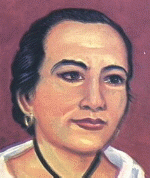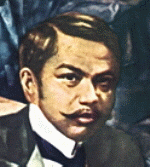
June 19, 1861-He was born in Calamba Laguna as the seventh child in a family of 11. His parents were Francisco Mercado Rizal and Teodora Alonzo y Quintos
1864 -At the age of 3, he learned the alphabet from his mother
1865 -at 5, while learning to read and write, he already showed inclinations to be an artist. He astounded his family and relatives by his pencil drawings and sketches and by his moldings of clay.
1869 -At the age 8, he wrote a Tagalog poem, "Sa Aking Mga Kabata," the theme of which revolves on the love of one’s language.
1877- at the age of 16, he obtained his Bachelor of Arts degree with an average of "excellent" from the Ateneo Municipal de Manila. In the same year, he enrolled in Philosophy and Letters at the University of Santo Tomas, while at the same time took courses leading to the at the Ateneo.
March 21, 1877- He finished the ldegree of surveyor and expert assessor.
March 21, 1878-He passed the Surveyor’s examination. but because of his age, 17, he was not granted license to practice the profession until December 30, 1881.
Biography of Jose Rizal in timeline format
1878- He enrolled in medicine at the University of Santo Tomas but had to stop in his studies when he felt that the Filipino students were being discriminated upon by their Dominican tutors.
May 3, 1882, he sailed for Spain where he continued his studies at the Universidad Central de Madrid.
June 21, 1884, at the age of 23, he was conferred the degree of Licentiate in Medicine.
June 19,1885, at the age of 24, he finished his course in Philosophy and Letters with a grade of "excellent."
Having traveled extensively in Europe, America and Asia, he mastered 22 languages. These include Arabic, Catalan, Chinese, English, French, German, Greek, Hebrew, Italian, Japanese, Latin, Malayan, Portuguese, Russian, Sanskrit, Spanish, Tagalog, and other native dialects. A versatile genius, he was an architect, artists, businessman, cartoonists, educator, economist, ethnologist, scientific farmer, historian, inventor, journalist, linguist, musician, mythologist, nationalist, naturalist, novelist, ophthalmic surgeon, poet, propagandist, psychologist, scientist, sculptor, sociologist, and theologian. He was an expert swordsman and a good shot.
March 1887-His daring book, NOLI ME TANGERE, a satirical novel exposing the arrogance and despotism of the Spanish clergy, was published in Berlin; in 1890 he reprinted in Paris, Morga’s SUCCESSOS DE LAS ISLAS FILIPINAS with his annotations to prove that the Filipinos had a civilization worthy to be proud of even long before the Spaniards set foot on Philippine soil
September 18, 1991- EL FILIBUSTERISMO, his second novel and a sequel to the NOLI and more revolutionary and tragic than the latter, was printed in Ghent.
July 6, 1892-July 15, 1892-He was imprisoned in Fort Santiago on a charge that anti-friar pamphlets were found in the luggage of his sister Lucia who arrive with him from Hong Kong.
While a political exile in Dapitan, he engaged in agriculture, fishing and business; he maintained and operated a hospital; he conducted classes- taught his pupils the English and Spanish languages, the arts. The sciences, vocational courses including agriculture, surveying, sculpturing, and painting, as well as the art of self defense; he did some researches and collected specimens; he entered into correspondence with renowned men of letters and sciences abroad; and with the help of his pupils, he contracted water dam and a relief map of Mindanao- both considered remarkable engineering feats.
November 3, 1986 -December 30, 1896. He was imprisoned again in Fort Santiago In his prison cell, he wrote an untitled poem, now known as "Ultimo Adios" which is considered a masterpiece and a living document expressing not only the hero’s great love of country but also that of all Filipinos. After a mock trial, he was convicted of rebellion, sedition and of forming illegal association.
December 30, 1896- Rizal was shot at Bagumbayan Field.
Tags:
Jose Rizal biography,
timeline




















